Tung Chung Battery
| Tung Chung Battery | |
|---|---|
| Native name 東涌小炮台 (Chinese) | |
 Tung Chung Battery | |
| Location | Lantau Island, Hong Kong |
| Built | 1817 |
| Designated | 11 November 1983 |
| Reference no. | 22 |
| Tung Chung Battery | |||||||||||||
|---|---|---|---|---|---|---|---|---|---|---|---|---|---|
| Traditional Chinese | 東涌小炮台 | ||||||||||||
| Simplified Chinese | 东涌小炮台 | ||||||||||||
| |||||||||||||
Tung Chung Battery is a former artillery battery located on Lantau Island in Hong Kong. Named after the eponymous district it is situated in, it was built in 1817, twenty-four years before the British took possession of Hong Kong. It was rediscovered in 1980 and is a declared monument of Hong Kong.
History
[edit]Construction of the Tung Chung Battery was completed in 1817.[1] Located a kilometre north of the Tung Chung Fort,[2] its purpose was to protect Tung Chung Bay[3] from pirates that threatened the coasts and seas of southern China. At the time, China did not have a large navy, and thus, relied on the development of forts as an alternative way to defend its coast.[4]
The coastal fortification consisted of two coastal artillery cannon emplacements that guarded the Bay, along with seven guard houses. The site of the battery was chosen because it was located on a cliff that overlooked the water. This provided excellent views of the sea and a clear vantage point in case of a potential naval attack.[4]
The construction of the battery was recorded in the Guangdong Annals, which recounted how two forts were built at the base of the "Rocky Lion Hill"[1]—the literal translation of Shek She (石師).
Rediscovery
[edit]
After having been buried underneath thick foliage for approximately a century, the battery was rediscovered in 1980.[2] All that remained was an L-shaped wall that contained a corner platform; according to the Antiquities and Monuments Office (AMO), this was most likely utilized as a gun emplacement. After the discovery, the government undertook restoration work on the historic site.[1] The battery was declared a monument on 11 November 1983.[5] In November 1997, the site was included in the AMO's celebration tour of historic sites in North Lantau as part of the Year of Heritage. The festivities culminated in a traditional Cantonese opera performed at the Tung Chung Fort.[6] Due to the amount of development that has taken place, the battery now faces towards Hong Kong International Airport, instead of Chek Lap Kok island and an open Tung Chung Bay as it used to.[3]
See also
[edit]References
[edit]- ^ a b c "Tung Chung Battery, Lantau Island – Declared Monuments". Antiquities and Monuments Office. Government of Hong Kong. Retrieved 10 March 2013.
- ^ a b Stone, Andrew; Chen, Piera; Chow, Chung Wah (1 February 2010). Hong Kong & Macau 14. Lonely Planet. p. 145. ISBN 9781741792256. Retrieved 17 March 2013.
- ^ a b Currie, Mike (7 December 1997). "Lantau's memories for the keeping". South China Morning Post. p. 3. Retrieved 17 March 2013. (subscription required)
- ^ a b Owen, Bernie; Shaw, Raynor (2007). Hong Kong Landscapes: Shaping the Barren Rock. Hong Kong University Press. p. 164. ISBN 9789622098473. Retrieved 17 March 2013.
- ^ "Annex I Listing of Declared Monuments". Environmental Protection Department. Government of Hong Kong. 1 January 1999. Archived from the original on 28 October 2009. Retrieved 10 March 2013.
- ^ "Free fort opera 'sells out'". South China Morning Post. 29 November 1997. p. 4. Retrieved 17 March 2013. (subscription required)
